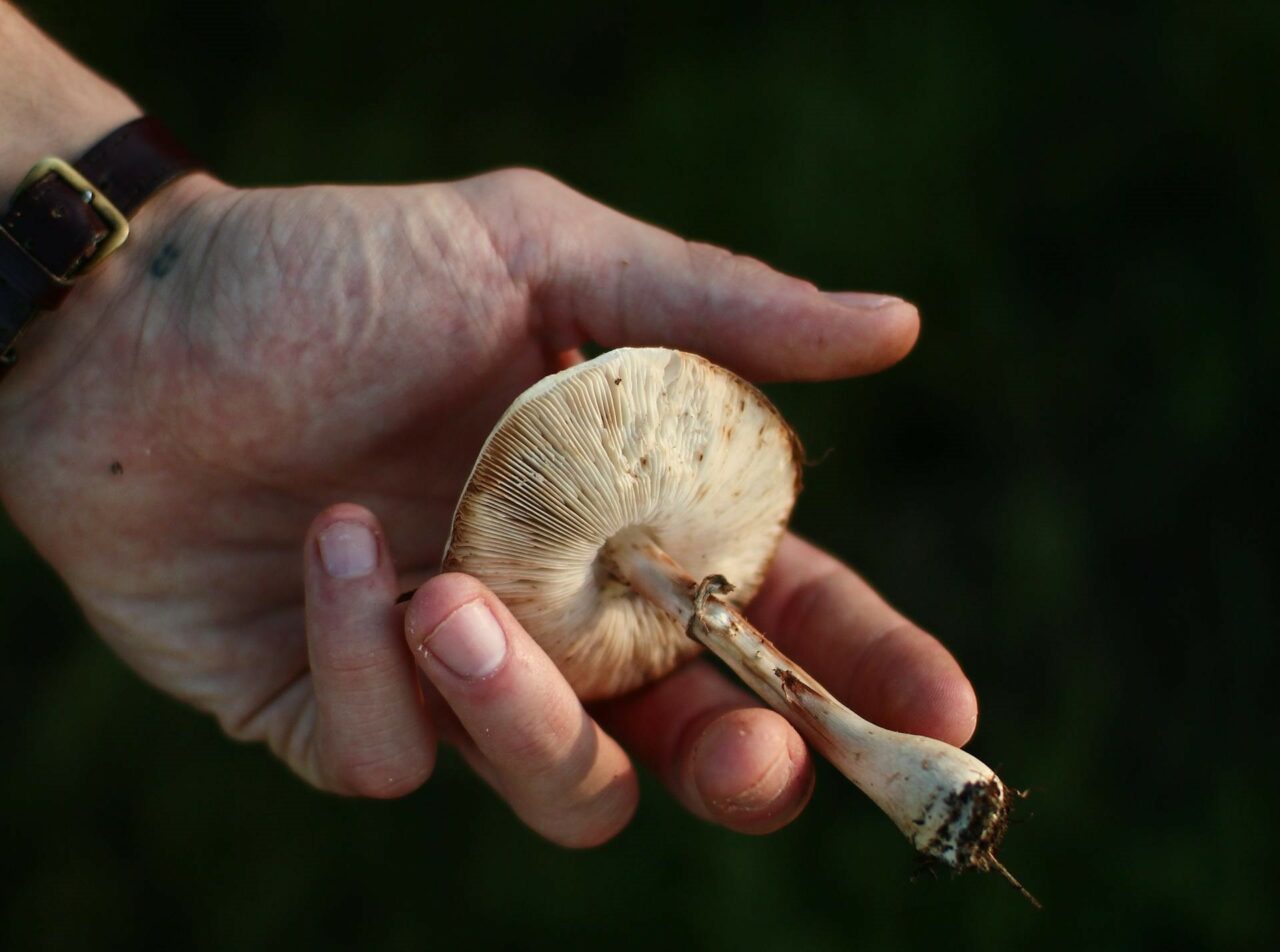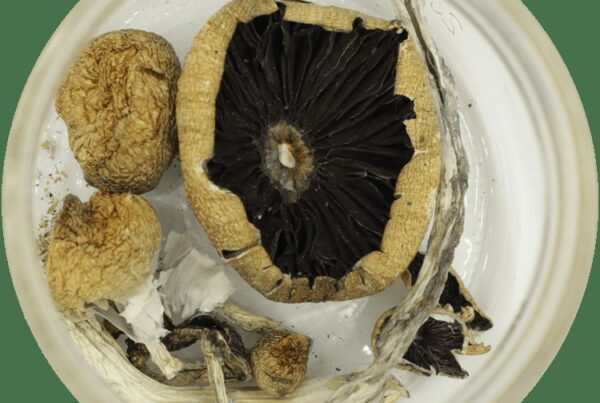Traditional psychedelics like Psilocybin mushrooms, similar to LSD in their role as a serotonin 5-HT2A receptor agonist, are presently a focus of study in psilocybin-enhanced therapy. These studies aim to address mental health disorders such as emotional distress linked to severe depression, anxiety, migraines, and cluster headaches.
Understanding the way shrooms assist with these conditions involves exploring how they are metabolized in the body. This knowledge empowers both researchers and users to understand how the active ingredient creates therapeutic and psychological effects. This article offers a basic summary of the pharmacology and pharmacokinetics of psilocybin.
[toc]
Key Points:
- Half of the ingested psychedelic fungi is absorbed and disseminated throughout the body.
- The fungi’s compound is dephosphorylated via the enzyme alkaline phosphatase, mainly in the liver.
- Approximately 3.4% of the compound is expelled in its original form within 24 hours, with a majority being discharged as a stable metabolite.
What is Pharmacokinetics?
Pharmacokinetics (PK) involves studying how substances, such as drugs, are processed by the body once ingested. It is distinctly related to pharmacodynamics, which investigates how a compound interacts with the body. PK explores four main factors: absorption, distribution, metabolism, and excretion (ADME).
Understanding these processes equips healthcare professionals to prescribe the most effective medications with the least risk. It also allows them to customize treatments based on each patient’s unique physiological needs and lifestyle.
The Application of Pharmacokinetics to Psilocybin
Psilocybin and psilocin, the primary active compounds in some species of magic mushrooms, have been the subject of significant interest among users and researchers. Pharmacokinetics studies how the body processes mushrooms containing psilocybin, aiding in understanding their potential medicinal or recreational effects.
These compounds are identified by various names, including “magic,” “psychedelic,” “medicinal,” or “sacred.” The fungi housing these compounds are consumed, with The mushroom species, their geographical origin, size, growth and drying conditions, and age can significantly influence their concentration levels.
Although these mushrooms naturally grow in the wild, scientists have engineered ways to create them synthetically in a lab. Both the natural and the lab-grown versions have low toxicity levels. However, minor side effects such as nausea or vomiting can occur.
Despite these minor physical side effects, the compounds within the mushrooms have proven to have potential therapeutic benefits due to their safe profile and non-addictive nature. This has led to further research into their use in psychotherapy, specifically as a treatment for anxiety and depression.
Four Stages of Pharmacokinetics
Psilocybin, the compound present in these mushrooms, is inactive in its natural state and operates as a prodrug, converting into its active form, psilocin. Enzymes such as alkaline phosphatase facilitate this transformation, enabling psilocin to be absorbed and distributed throughout the body to various tissues. However, psilocybin cannot be detected in the circulatory system, feces, or urine after oral administration.
Absorption
Absorption refers to the process where the compound enters the bloodstream from its site of administration. This process affects the speed and effectiveness at which the compound reaches its target, such as the plasma. Oral administration is the most common route, while inhalation has been tried but found less effective.
The absorption process also includes the release of the compound from the dosage form during oral ingestion. Factors such as delays in the throat or esophagus can affect this process, potentially causing slower results or irritation. Once the compound reaches the stomach, the acidic environment might start to degrade it before it enters the bloodstream.
Studies on animals suggest that only around 50% of orally ingested psychedelics are absorbed and distributed throughout the body.
Factors Affecting the Absorption Process
The absorption process can be influenced by several factors, leading to variations in the onset, intensity, and duration of its effect:
- Stomach Contents: The presence of food in the stomach can slow down the process by delaying the onset of effects. Faster absorption can be achieved with an empty stomach.
- Body Fat: Substances may accumulate in fat tissues, potentially prolonging their effects.
- Age: Metabolism rates and body composition typically vary with age.
- Zero-Order Kinetics: The substance is expelled at a steady rate, regardless of its concentration.
- First-Order Kinetics: The elimination rate is directly proportional to the drug’s concentration.
Various factors such as the product’s size, polarity, and protein-binding capability, as well as an individual’s physiology—including hydration status and body composition—have a crucial role in this process.
The aim is to achieve an effective concentration at the target location. For efficiency, the product must reach the specified area, as dictated by the volume of distribution, and remain unlinked to proteins, which allows it to actively engage with its receptor.
What Factors Affect the Dispersion Process?
Several factors can influence the dispersion process:
Effects generally begin to manifest between 20-40 minutes after ingestion, peaking around 80-100 minutes. The effects of magic mushrooms usually persist for about 4-6 hours.
How Does Dispersion to the Brain Happen?
An initial experimental study on two species showed that its binding affinity order is 5HT2A > 5HT1A > 5HT2B [23]. It also binds to dopamine D1, 5HT1E, 5HT5A, 5HT7, 5HT6, D3, 5HT2C, and 5HT1B receptors.
It acts as a partial agonist at the 5HT2A receptor, with an efficacy of around 40%. The psychedelic effects can be traced back to its partial agonist activity at 5HT1A autoreceptors.
The mood-boosting and psychotomimetic experiences may be attributed to the noted correlation between increased dopamine levels and sensations of depersonalization and bliss. Hallucinogens work by modifying neurochemistry and receptor actions. It enhances 5HT2A agonist activity by stimulating BDNF production in the hippocampus, which fosters neurogenesis and reduces conditioned fear-related behaviors.
Elimination
Elimination refers to the process by which the The human body expels a substance mainly through the kidneys, but also through the lungs, skin, or gastrointestinal tract. In the kidneys, a naturally occurring psychedelic drug undergoes filtration in the glomerulus, secretion in the tubules, and partial reabsorption, which adds complexity to the process.
The substance has a half-life of about 160 minutes, while psilocin has a half-life of approximately 50 minutes. Animal studies indicate that the substance is primarily expelled through urine, comprising about 65% within 8 hours of intake. Traces of the substance can still be detected in lower quantities in the bile and feces.
About 3.4% of the substance is excreted in its unaltered form within a day in humans. The majority is expelled as psilocin-O-glucuronide, a more stable metabolite. This stability allows the substance to be detected in urine samples over a longer time period.
There are two primary methods of substance removal:
Most psychedelic drugs are eliminated following the first-order kinetics method, reaching stable concentrations after four to five half-lives. Complete removal also happens after four to five half-lives.
Discover Our Range of Hallucinogenic Mushrooms
The metabolic process differs among various types of fungi. By sourcing from reliable online vendors like Shrooms Toronto Canada, you can avoid the risk of ingesting poisonous mushrooms. Certain varieties, such as Agaric mushrooms, can cause strong and undesirable effects. Therefore, it’s essential to obtain magic mushrooms from trustworthy dispensaries, and not from unreliable street vendors or directly from the wild.
| Feature | Enigma | Full Moon Party | Gold Member | |
| Strain Type | Psilocybe Cubensis OMNI | Psilocybe cubensis (Thai Koh Samui) | Psilocybe cubensis | |
| Potency | Exceptionally high; 3.8% tryptamine content | Moderate to high potency | High potency | |
| Visual Characteristics | Resembles a blob or | Resembles a cauliflower or brain-like structure | Exhibits a classic cubensis look; moderately sized | Features thick white stems; golden caramel caps; noticeable blue bruising |
| Effects | Known to be the most potent; generates intense effects | Delivers a powerful mental high; onset is delayed but visuals are pronounced | Produces potent visuals and a sense of euphoria |
Online Learning About Psilocybin Mushroom Usage
For medical professionals, researchers, and users, understanding the pharmacokinetics of shrooms is crucial. This knowledge will help make informed decisions regarding dosage and timing, thus reducing potential risks.
Discover your perfect psychedelic experience at Shrooms Toronto Canada. Whether you’re in search of a soothing journey or a deeper exploration, our wide variety of products is designed to meet your unique needs. We provide high-quality, safe, and controlled shrooms, eliminating worries about dubious sources or harmful mushrooms.
Explore the best magic mushrooms Canada has to offer and take your psychedelic experience to new heights.
Frequently Asked Questions
Are there any known interactions between shrooms and other drugs?
Our products may interact with some medications, particularly those affecting serotonin levels like SSRIs (Selective Serotonin Reuptake Inhibitors). SSRIs and SNRIs (Serotonin and Norepinephrine Reuptake Inhibitors) can lower the effects, unlike non-serotonergic antidepressants. This reduced effect can last for up to three months after discontinuing the antidepressant use.
Do all psychedelics follow the same pathway as psilocybin?
No, each psychedelic substance has a unique structure that requires different metabolic processes to activate, and they bind to various receptors in the body. The way each psychedelic is administered also affects how it’s absorbed. While the fundamental principles of absorption, metabolism, and distribution are consistent, the specific pathways and effects differ for each substance.
Can the form of the shroom affect the pharmacokinetics?
Yes, the form (whether fresh, powdered, or dried mushrooms) can influence the absorption rate. For example, powdered forms may be absorbed more quickly than whole dried ones due to faster dissolution.
Suggested Reads:





